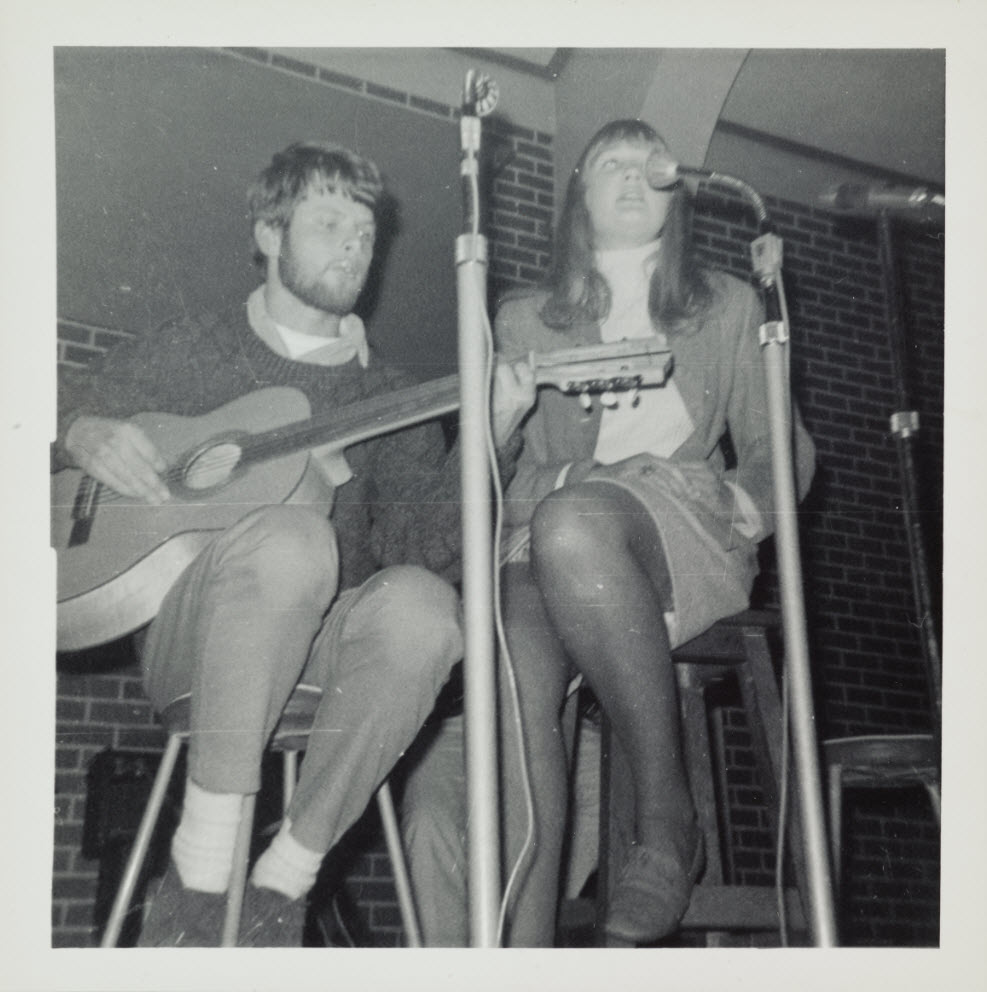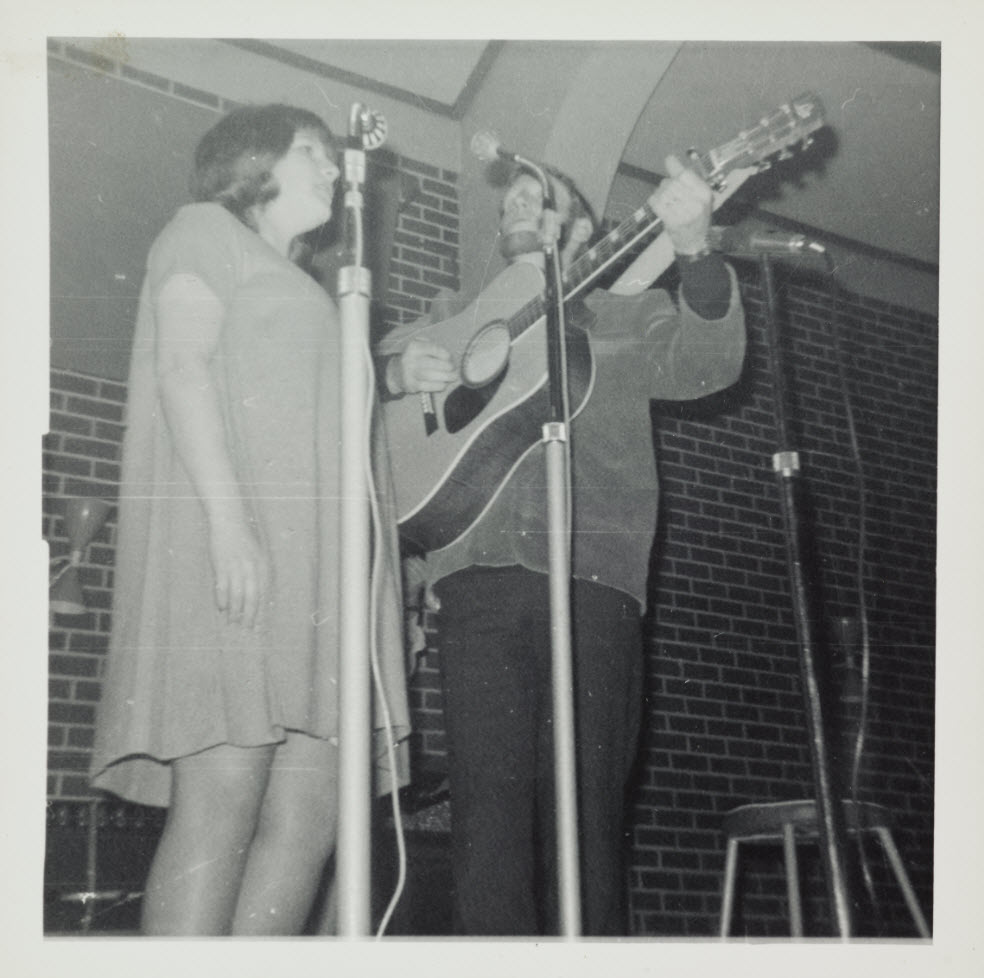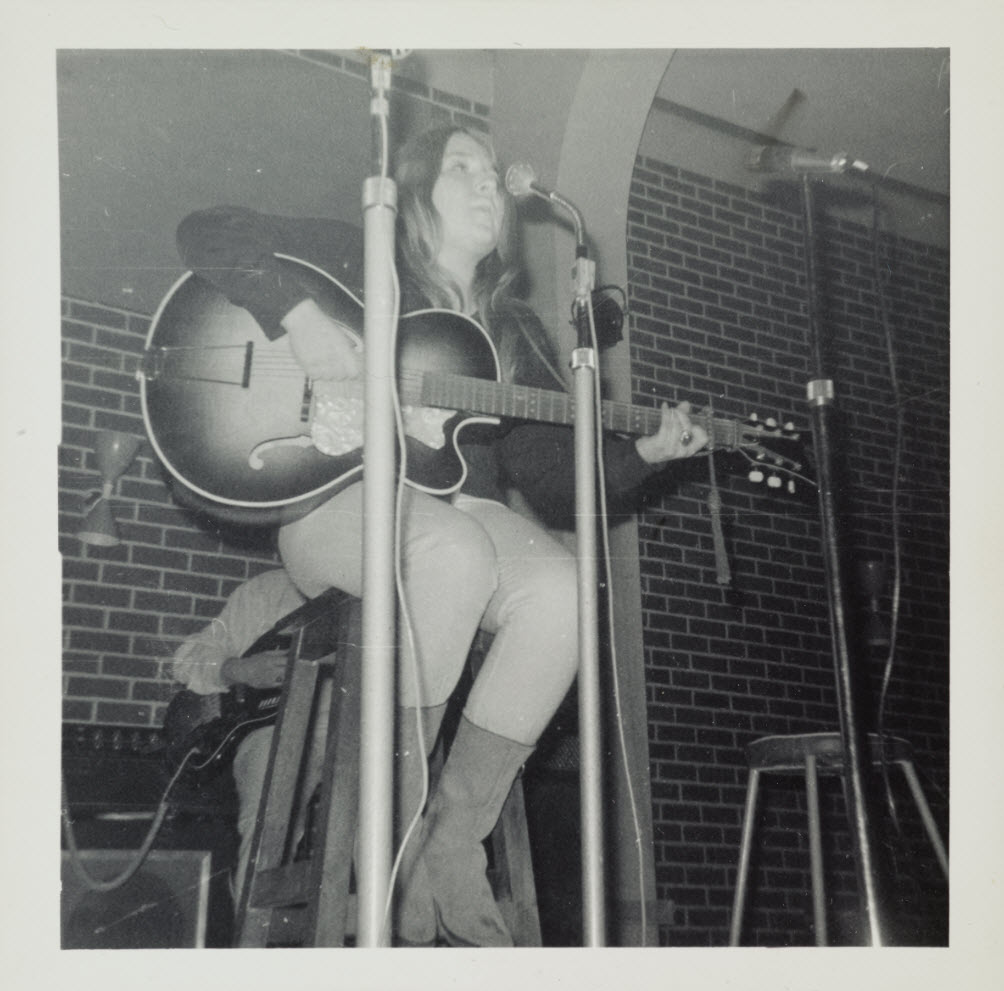
AG-047-7/004. Photograph of unnamed performers. Folk Proms Concert Capping, 1967. Otago University Folk Music Club: Files. Hocken Collections, Uare Taoka o Hākena, University of Otago.
Post researched and written by HUMS 301 intern Kayli Taylor.
How power (im)balances mean minorities are not adequately represented, including in archives.
Gordon Spittle’s Beat Groups and courtyard parties provides a broad snapshot of the underground culture of the Ōtepoti Dunedin music scene in the 1960s. The book offers a raw depiction of collectives of artists, musicians and performers who set the stage for the city’s emerging Dunedin sound. The book also contains a distinct lack of representation of women. Therefore, one might be forgiven for thinking that there were no women performing in the 1960s. An in-depth analysis of the Hocken archives, as I did for my HUMS301 internship, tells another story. Women did perform but were simply represented less than men. This has implications for how historians and archivists discuss women in the Dunedin music scene, and how we can do research to understand their lives and experiences.
The research I undertook at Hocken was broad, looking at publications and archives. In particular, the archival material on the Otago University Folk Music Club AG-047/7 provided different representation of women. Publications such as student magazine Critic, the Otago Daily Times and Playdate also provided interesting points of analysis.
In the 1960s, folk music expanded across Ōtepoti Dunedin and the world.[1] A key aspect of folk music was the role of women.[2] Through the archival records of the Otago University Folk Music Club, we can see that women played a key role in the organisational management of the group. This includes Diane Baird, Wendy Clark, Catherine Monthieth, Di Looney, Liz Somerville, Lyn Jeffcoate, and Bronwyn Patterson. Women also performed in concerts organised by and connected with the group, including Di Looney, Val Murphy, Lea Stevens, Christine Smith, Brownyn Patterson and Ann Wigston.
An article published in student magazine Critic in 1961 recognised this phenomenon, saying there was a shift to women performing in concerts on the basis that if women are good enough to perform behind the scenes, they are deserving of performing.[3]
The representation of women in the music scene in Dunedin in the media is also of interest to our analysis of women in the Dunedin music scene in the 1960s. Critic, for example, includes discussion of women and their role in the Dunedin music scene. In particular, Critic shows that folk music has quite extensive representation of women. Women, such as Diane Baird and Juliet Scott, also wrote for Critic about music – showing another way that women could speak into the Dunedin music scene in the 1960s.

AG-047-7/001. Photograph of unnamed performer. Folk Proms Concert Capping, 1967. Otago University Folk Music Club: Files. Hocken Collections, Uare Taoka o Hākena, University of Otago.
Expanding to look at women musicians across Aotearoa New Zealand, we can see that women both performed – and were represented. Musicians such as Sandy Edmonds, Dinah Lee, Maria Dallas and Kiri Te Kanawa were regularly represented in Playdate. The way they were represented is still of note, however. They were often used in advertising, such as for hair product Napro. These products were advertised by Dinah Lee (seven times), Anne Murphy (one time) and Sandy Edmonds (nine times).
Analysing the representation of women in the Dunedin music scene in the 1960s shows common threads of the representation of minorities. David Thomas’s Silence in the Archive argues that archives are not neutral or natural, but hold particular stories and reinforce particular discourses.[4] He argues that though archives should be beacons of light to the stories of history, that is not always the case.[5] We can see this playing out in the lack of representation of women in the Dunedin music scene.
The Ōtepoti Dunedin music scene has an interesting history of its presence and representation of women. The 1960s, in particular, was a key point of flux and transition. Women played an increasingly role in the music scene but were rarely recognised in the media of the day. For historians, this poses a challenge to how they perceive and understand women and their involvement. Thomas argues that as historians seek stories of minorities, there is not always the archival material to assist their research.[6]

AG-047-7/003. Photograph of unnamed performers. Folk Proms Concert Capping, 1967. Otago University Folk Music Club: Files. Hocken Collections, Uare Taoka o Hākena, University of Otago.
While I found some representation of women in the Dunedin music scene in the 1960s, I believe there were more women performing than the archive represents. David Thomas argued that archives silence some stories, and I believe this is the case in this instance. This encourages us – as historians and people – to act more consciously to find and represent the stories of women and minorities in the archives, and to make space for their stories in our everyday lives.
Dunbar, Julie C. Women, Music, Culture: An Introduction. Second Edition. ed. New York: Routledge, 2016.
Thomas, David, Simon Fowler, and Valerie Johnson. The Silence of the Archive. London: Facet Publishing, 2017.
[1] Julie C. Dunbar, Women, Music, Culture: An Introduction, Second Edition. ed. (New York: Routledge, 2016), 364.
[2] Ibid.
[3] “More Women Take An Active Part in Concert”, Critic, 4 May 1961, 8.
[4] David Thomas, Simon Fowler, and Valerie Johnson, The Silence of the Archive (London: Facet Publishing, 2017), 1.
[5] Ibid., 22.
[6] Ibid., 17.


Did any of these women release albums? It would be interesting if someone could release a compilation of their recordings if they exist.
Kia ora Eric
My apologies for not replying earlier. Unfortunately WordPress doesn’t always notify when we get comments. Our Curator Music and AV is investigating and I will reply again when we know more. Anna Blackman.
Kia ora Eric
Thank you for your email. Anne Murphy and Christine Smith have released music commercially, but we don’t think any of the other musicians listed have, as we can not find any recordings by them. If they have released music, we would love to include it in our collections!
Amanda Mills